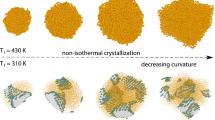Abstract
Orientation and stretch of entangled polymers under large step shear deformations were investigated through primitive chain network simulations. In the simulations, entangled polymer dynamics is described by 3D motion of entanglements, 1D sliding of monomers along the chain, and creation/destruction of entanglements described by hooking/unhooking with surrounding chains at chain ends. In addition to the conventionally proposed relaxation mechanisms that are reptation, contour length fluctuations, and constraint release (both thermal and convective), the simulations also account for force balance among entanglement strands converging to an entanglement node, and nodes also fluctuate in space. Nonlinear step strain data for monodisperse polystyrene melts (Ferri and Greco, Macromolecules, 37:5931, 2006) were quantitatively reproduced by using the same two molecular-weight-independent parameters already adopted by Masubuchi et al. (J Non-Newt Fluid Mech, 149:87, 2008) to fit linear viscoelastic data of several monodisperse polystyrene melts. Analysis of the orientation tensor and of the chain stretch ratio indicates that the segment orientation and stretch realized in the simulation are quantitatively described by a simple three-chain model (Marrucci et al., Macromol Symp, 158:57, 2000a).






Similar content being viewed by others
References
Doi M, Edwards SF (1986) The theory of polymer dynamics. Clarendon, Oxford
Ferri D, Greco F (2006) Macromolecules 39:5931–5938
Ferry JD (1980) Viscoelastic properties of polymers. Wiley, NewYork
Furuichi K, Nonomura C, Masubuchi Y, Ianniruberto G, Greco F, Marrucci G (2007) J Soc Rheol Jpn 35:73–77
Graessley WW (1982) Adv Polym Sci 47:68–117
Greco F (2004) Macromolecules 37:10079–10088
Ianniruberto G, Marrucci G (2001) J. Rheol 45:1305–1318
Larson RG (1988) Constitutive equations for polymer melts and solutions. Butterworths, New York
Marrucci G (1996) J Non-Newtonian Fluid Mech 62:279–289
Marrucci G, Greco F, Ianniruberto G (2000a) Macromol Symp 158:57–64
Marrucci G, Greco F, Ianniruberto G (2000b) J Rheol 44:845–854
Masubuchi Y, Takimoto JI, Koyama K, Ianniruberto G, Marrucci G, Greco F (2001) J Chem Phys 115:4387–4394
Masubuchi Y, Ianniruberto G, Greco F, Marrucci G (2003) J Chem Phys 119:6925–6930
Masubuchi Y, Ianniruberto G, Greco F, Marrucci G (2008) J Non-Newtonian Fluid Mech 149:87–92
McLeish TCB (2002) Adv Phys 51:1379–1527
Mead DW, Larson RG, Doi M (1998) Macromolecules 31:7895–7914
Menezes EV, Graessley WW (1982) J Polym Sci Polym Sci Polym Phys Ed 20:1817–1833
Peters EAJF, van Heel APG, Hulsen MA, van den Brule BHAA (2000) J Rheol 44:845–854
Schieber JD (2003) J Chem Phys 118:5162–5166
Watanabe H (1999) Prog Polym Sci 24:1253–1403
Acknowledgment
Two of the authors (KF and CN) wish to acknowledge TOYOBO Co., Ltd. for the permission to publish this paper.
Author information
Authors and Affiliations
Corresponding author
Appendices
Appendix A
The Rouse time for stress relaxation (1/2 the end-to-end vector relaxation time) can be written as (Doi and Edwards 1986)
where \(\varsigma _m \) is the friction coefficient of a monomer (Kuhn segment), N m is the chain monomer number, b is the Kuhn length, and kT is thermal energy. The time τ 0 used as unit time in the simulations is defined as:
In this equation, ζ is the friction coefficient associated to one node of the network. Using the relation \( \zeta = 2n_0 \varsigma _m \) and eliminating b from Eqs. 10 and 11 gives the Rouse time in the form:
Appendix B
Polar decomposition of the deformation gradient tensor is written as \( {\mathbf{E}} = {\mathbf{C}}^{ - \frac{1} {2}} \cdot {\mathbf{R}} \), where \( {\mathbf{C}}^{ - \frac{1} {2}} \) is the square root of the Finger tensor and R is the rotational tensor (Larson 1988). Using the polar decomposition, the Doi–Edwards Q tensor without IAA (Doi and Edwards 1986) is written in the form
similar to that used by Peters et al. (2000) for the Q tensor with IAA. In the case of chains aligned to a simple cubic lattice as assumed in the three-chain model, the orientational distribution of bond vectors at equilibrium is given by
where δ is Dirac delta function and i, j, and k are the principal vectors of the deformation. From Eq. 14, we then obtain:
For R = I (unit tensor), these equations reduce to:
giving for the Q tensor of the three-chain model:
Rights and permissions
About this article
Cite this article
Furuichi, K., Nonomura, C., Masubuchi, Y. et al. Entangled polymer orientation and stretch under large step shear deformations in primitive chain network simulations. Rheol Acta 47, 591–599 (2008). https://doi.org/10.1007/s00397-008-0258-3
Received:
Revised:
Accepted:
Published:
Issue Date:
DOI: https://doi.org/10.1007/s00397-008-0258-3




